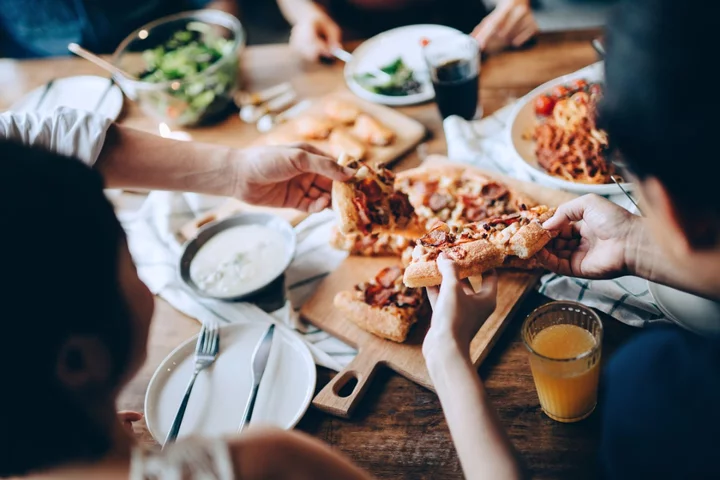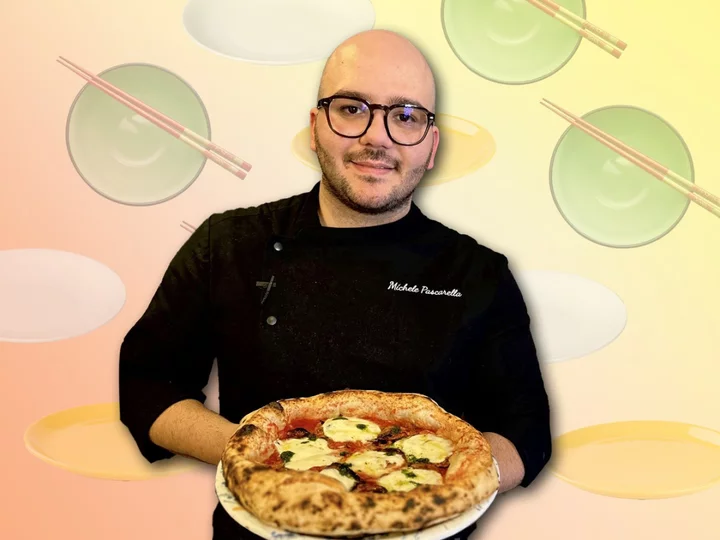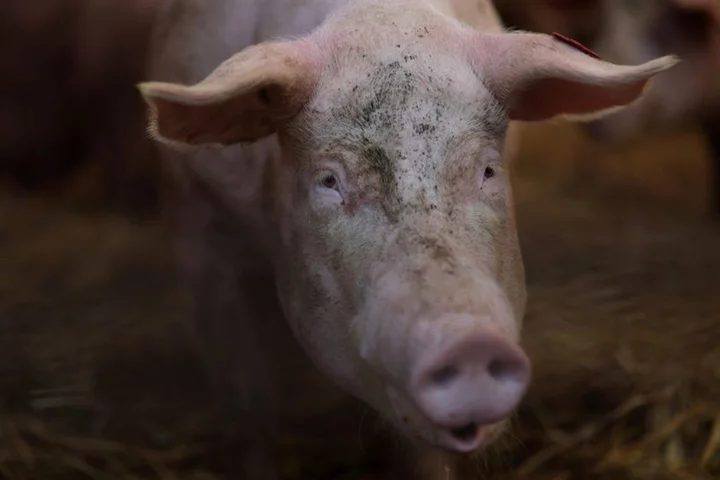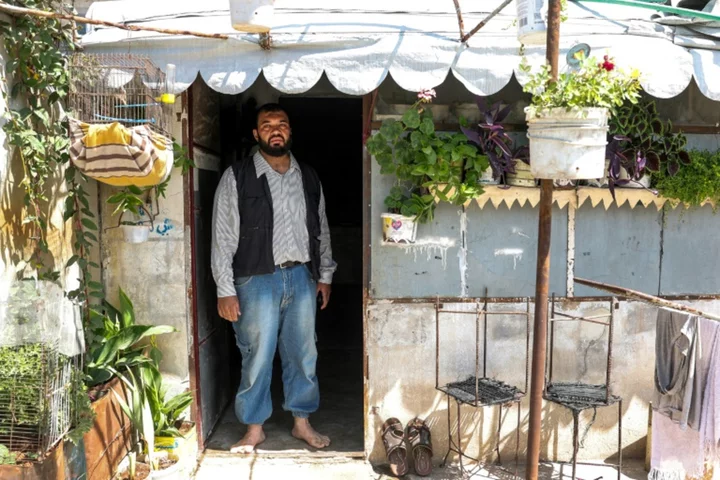
Abaya controversy tests French schools' secular limits
A reported increase in Muslim girls wearing the abaya dress at French schools has triggered a debate about their violation of the country's sacrosanct...
2023-06-21 14:57

China Slowdown Adds to Boycott Woes for Japanese Beauty Stocks
As companies battle to grab a bigger share of Asia’s growing cosmetics market, they’re receiving an unhappy reminder
2023-11-16 06:47

The Enduring Enigma of Costco’s $1.50 Hot Dog and Soda Combo
In an era of rampant price increases, the cost of Costco's meal combo hasn't changed in nearly 40 years.
2023-08-31 22:56

Brits will eat over 5,000 slices of pizza in their adult life, study finds
The typical Brit will munch through 5,208 slices of pizza over the course of their adult life – but 83 per cent have no regrets about the amount they eat. A poll of 2,000 adults found 12 per cent eat up to three pizzas each week – with between 6pm and 8pm being the most popular time to chow down. This equates to an average of £21.40 a month on the beloved Italian classic – or £256.80 a year. In fact, 40 per cent are picking pizza over other meals and snacks with 18 per cent saying they’re likely to reach for a slice over other takeaway treats like kebabs (three per cent) or an Indian takeaway (15 per cent), because it makes them happy (42 per cent). With 57 per cent citing it as their ‘comfort food’. The research, commissioned by Tabasco Brand to celebrate National Pizza Month, also found Friday (24 per cent) and Saturday (21 per cent) are the preferred days to tuck into the dish. A spokesperson for the hot sauce maker said: “Pizza is an easy way to bring people together as the ultimate dish to share with friends and family. “Great for any occasion, the cheesy goodness with an added dash of hot sauce is a great way to light up any movie night or end of week celebration.’ Ordering it to your home (46 per cent) is the preferred location to eat pizza, as opposed to at a restaurant (18 per cent). The study, carried out via OnePoll, also found the nation’s top ‘pizza moments’ are a movie night at home (36 per cent) and after a night on the town (29 per cent). Pizza-lovers are also growing more adventurous, with 48 per cent experimenting with different flavours and toppings, citing combinations like hot sauce and mayo (17 per cent), hot sauce and honey (15 per cent) and hot sauce and queso (13 per cent) as the blends they’re most likely to explore. And when it comes to toppings, mushrooms (37 per cent), mozzarella (37 per cent) and onions (33 per cent) come in the top three – with pepperoni (31 per cent per cent) and garlic (26 per cent) just behind. The spokesperson for Tabasco Brand, which has teamed up with Yard Sale Pizza to allow Londoners to share custom messages to friends and family via its Yard Sale x Tabasco Pizza Post, added: “It’s great to see that people are open to experimenting with some seriously hot combinations. “Pizza is a great medium for this. Its cheesy base counteracts the heat from the hot sauce, allowing people to try out flavours that seem spicier than they’re used to. “Plus, the acidity of the vinegar cuts through the rich toppings, deepening the flavour and taste of the pizza. Together, the combination can light up even the simplest of pizzas.” The best time to enjoy a pizza: 1. A movie night at home 2. On a Friday night after a long week at work 3. When watching sports on TV 4. As a payday treat 5. Getting in after a night out 6. The day you get back from a holiday 7. The day you move house and don’t want to cook 8. As a celebration – like on exam results day 9. Your birthday 10. Leftovers as a treat lunch at work Read More Brits admit they’re ‘clueless’ about art including paintings by Pablo Picasso Brits get itchy feet in their home after five years, study finds The exact time Brits find themselves ‘uncontrollably hungry’ revealed Is there such a thing as British pizza? Jamie Oliver says he’d choose anonymity over fame if given the choice again
2023-10-03 20:15

In-N-Out owner reveals where ‘animal style’ name comes from
In-N-Out’s classic “animal style” burger and fries used to be a secret menu item at the fast food chain, but has since become one most customers are now familiar with. The option became so popular that it is now listed under the “not so secret menu” category on In-N-Out’s website. As for what it entails, “animal style” refers to a burger with a beef patty grilled with mustard then served with pickles, lettuce, grilled onions, and extra spread on a toasted bun. Animal style fries, meanwhile, are topped with cheese, spread, and grilled onions. Although part of the menu, it wasn’t previously clear where the name for the burger joint’s style came from, until now. Lynsi Snyder, one of the owners of In-N-Out, is sharing the chain’s secret, and other unknown details about the restaurant, in her book set to come out in October titled, The Ins-N-Outs of In-N-Out Burger: The Inside Story of California’s First Drive-Through and How it Became a Beloved Cultural Icon. According to Insider, which received an advance copy of Synder’s book, one of the sections is called “Birth of Icons,” in which Synder discussed how the “animal style” burger was named. It turns out that animal comes from rowdy customers or “animals.” Snyder wrote that these customers “would honk their horns while orders were taken,” or they would “leave trash on the lots and play their music extra loud”. According to Syner, they were sometimes so rowdy they would get into fights with each other. At the time, employees at In-N-Out were called “helpers” who began to call these customers “animals.” “Good naturedly, the helpers inside referred to them as ‘animals,’” Snyder wrote. She added that, one night in 1961, an “animal” spotted a manager making himself a burger. The joint was originally designed with floor-to-ceiling windows so customers could watch burgers being prepared, which was co-founder Harry Snyder’s idea, as he “believed customers would enjoy seeing their food made with care,” Snyder explained. The customer was intrigued as to what this burger was and asked him what was in it. “It’s mustard fried,” Roberts responded, according to the book. “I add pickles, grilled onions, and extra spread.” In response, the customer said: “Sounds amazing. Can you make me one too?” according to the book. Roberts obliged, and “the guy wolfed it down,” calling it the best burger he ever had, Snyder wrote. The customer liked it so much that he continued to order it, but had no idea what to call. Eventually Roberts told him, “Just call it Animal Style,” according to Synder. “That’s how Animal Style burgers got their name, and the request is the first known instance of a secret In-N-Out menu item,” Snyder wrote. Today, this style is a popular way to not only order burgers, but fries as well. Synder wrote that the case for other items on the “not so secret menu” comes from custom creations customers have come up with over the years. For example, the Double-Double was a custom “double meat, double cheese” off-menu order made by guests looking for a meatier meal, Snyder wrote. The Double-Double first appeared on the menu during the 1 August 1966 opening of store number six, according to the book. Read More Khloe Kardashian teases Kris Jenner for not knowing cost of fast food after she gave her $300 for In-N-Out Alexandria Ocasio-Cortez sparks debate after declaring In-N-Out ‘overrated’: ‘Thank you for saying this’ ‘We refuse to become vaccination police’: In-N-Out Burger is a leading mandate opponent on the West Coast Starbucks releases new fall menu with two brand-new drinks: ‘Pure joy’ What is the UK’s cheapest meal deal? Waitrose has launched its first ever lunchtime meal deal
2023-08-24 04:24

Palm Oil Extends Drop on Losses in Soyoil and Demand Concerns
Palm oil fell to its lowest level in more than a week on concerns about poor demand and
2023-09-21 16:22

Amazon Opens New Manhattan Offices at Former Lord & Taylor Site
Amazon.com Inc. has opened offices at the former Lord & Taylor building in midtown Manhattan, more than three
2023-09-13 00:58

Pan Am flight attendants had the most glamorous jobs in the sky. Here's what happened when the airline vanished
Pan Am flight attendants lived the high life, crisscrossing the globe and picking up cosmopolitan anecdotes. So what happened when the airline vanished? Seven former cabin crew reveal their journeys from Pan Am to acting, teaching, and practicing law.
2023-07-17 21:59

'Yellowjackets': Here's what happens when you call Lottie's cult
Given what we know about Lottie (Simone Kessell), you probably wouldn't want to join her
2023-05-17 18:18

The dish that defines me: Michele Pascarella’s Neapolitan ragu
Defining Dishes is an IndyEats column that explores the significance of food at key moments in our lives. From recipes that have been passed down for generations, to flavours that hold a special place in our hearts, food shapes every part of our lives in ways we might not have ever imagined. I was very young when I started working in a local pizzeria in Caserta, the city near Naples where I grew up. I was 11 years old when I started working there, and stayed on for about eight years before moving to London to start my own business. But during my teenage years, one of the best memories I have is waking up to the smell of my mother’s ragu on Sundays. Neapolitan ragu is a specialty in the region, and we are very proud of it. It’s one of the two most famous varieties of ragu, the other being ragu bolognese, and uses whole chunks of beef and pork rather than ground meat. It must be cooked for a long time over a low heat, for at least eight hours, preferably 10 hours. My mother would get up at 5am to start making hers and it would continue to simmer slowly until the family is ready to eat in the afternoon. Sundays are special because it’s a time for the whole family, including our extended family, to come together and eat at the same table. My family comprised of my parents, my three siblings and myself, and we would usually be joined by my grandparents, aunts, uncles, cousins. We usually had anywhere between 15 to 20 people gathering on Sunday afternoons. It didn’t matter what commitments you had – on Sunday, you have to sit at the table with family. It’s the most important day of the week for us. The ragu is the dish that, for me, brings everything together: passion, love, happiness and strong ties with family. Because I worked late shifts often, I would wake up really late on Sundays, around 11am or 12pm. So by the time I wake up, the beautiful aroma of the ragu that has been cooking since 5am will have filled the whole house. I would wake up so hungry. My breakfast on these days would simply be a hunk of bread, torn and dipped straight into the still-simmering sauce, with some parmigiano reggiano sprinkled on top to help cool it down. Every family has their own way of eating ragu. You can dip bread in it, like I did for breakfast, but it is most commonly eaten with pasta. Some people have it with gnocchi while others might use a short pasta or spaghetti. But it does have to be a robust pasta shape, you can’t have ragu with a really small pasta, or it won’t stand up to the sauce. No one makes ragu like my mother’s. I could go to any restaurant, even those with Michelin stars, and it wouldn’t come anywhere close to hers. I strongly believe her secret ingredient is just her love for cooking for her children, as the dish needs that passion to make it taste so good. I never woke up at 5am to try and make it with her, it was so hard when I was a teenager! But when I did start to learn how to make it, it was very difficult to get up that early. I don’t know how she did it for so many years. In my restaurant, Napoli on the Road, I make a pizza with the slow-cooked ragu as a topping, along with a parmigiano reggiano cream. I call it Ricordi D’infanzia, which translates to “childhood memories” because it holds such strong nostalgia for me. But I still can’t make it like my mother does. When I go home to Caserta to see my family, I do try to wake up at 5am to make it with her. I’m less stressed about work when I’m there so I can usually do it, but when I’m back in London it’s hard to get up at that hour when you finish at midnight at the restaurant. Like most mothers who pass down their recipes, there are no accurate measurements to my mother’s ragu. Sometimes they put some sort of secret ingredient inside and won’t tell you. But I have learnt that you need to be flexible about it, depending on what ingredients are available to you. For example, maybe the tomatoes you buy from the market are too acidic. My mother fixes this by putting a whole potato in the sauce, because its starchiness will help to remove the acidity from the tomatoes. Or, she might add sugar to the sauce to mellow it out. It can be tricky to get it right, so I can only try my best to do better than my mother, but it is hard. I think I will be 80 or 90 years old before I perfect my own version! I’ve lived in London for almost 20 years, but I still miss those Sunday afternoons spent with my family at my uncle’s or grandfather’s house. In London, things are very fast-paced and rushed, you don’t really have time to sit down with people. I try to go back every couple of months, and I really look forward to it. My mother still makes her ragu. Even though nowadays it’s harder to get everyone together, we do our best to keep everyone united. I don’t have any family in London, so it’s important to me to keep that tradition alive when I go home. My dad has never visited me here because he is afraid of flying, but my mother comes fairly often and I’ll make ragu for her when she does. She never says anything bad about it – although, she will tell people: “It’s good… but it can be improved.” Still, I’m glad I have the opportunity to make it for her sometimes and it keeps me connected to home. Michele Pascarella is the chef-owner of Napoli on the Road. Read More The dish that defines me: Evelin Eros’s rum cake The dish that defines me: Mallini Kannan’s baked honey-soy salmon The dish that defines me: Frank Yeung’s prawn wontons
2023-09-12 13:46

Reusable bottles contain 'more bacteria than toilet seats'
Reusable water bottles tick many boxes. Not only do they help you stay hydrated and help save money, but they also help cut down on single-use plastic. They've almost become a fashion accessory, with chic stainless steel flasks and viral bottles going viral across TikTok. Sign up for our free Indy100 weekly newsletter Trying to hit the NHS-recommended eight glasses of water a day for adults is an excellent idea, of course, but did you know there’s one way your refillable bottle could potentially be detrimental to your health? According to a study from waterfilterguru.com, reusable water bottles contain an average of 20.8m colony-forming units (CFUs) of bacteria, which equates to 40,000 times more than the microbes on a toilet seat. So what might be the consequences if you continuously sip and refill without washing your bottle properly between uses? We asked health experts to talk through the risks… Bottling up bacteria “A common misconception when it comes to reusable water bottle hygiene is that as you’re typically filling it with pure water and it’s only coming into contact with your own mouth, there’s little need to clean it often,” says Dr Donald Grant, senior clinician at The Independent Pharmacy. However, every time you drink from the bottle, you’re transferring bacteria from your mouth, which can then multiply in the container. “Anything that is reusable can be prone to accumulating dirt, dust or debris and, as a result, bacteria,” says private GP Dr Suhail Hussain. “This is exacerbated by the fact water bottles are the ideal environment for harbouring bacteria due to being moist.” Hard-to-reach crevices – for example, inside a screw top or under a flip-up straw – could also develop mould, and then there’s contamination from other sources. “When you store it in a gym bag, for instance, it can pick up bacteria from the interior of the bag or anything else stored in it, while you can also transfer bacteria from your hands to your bottle,” says Grant. “If your bottle has a valve cap, you may need to lift or twist it with your fingers, and this can transfer bacteria you may have picked up from touching other objects or surfaces.” What types of microbes are found in water bottles? “These might be simple commensals such as streptococcus and staphylococcus, which normally live in symbiosis with their host (i.e. us) but can become problematic if they accumulate or the individual is under the weather,” Hussain says. “Bacteria such as E. coli – a common cause of urine and bowel infections – can often colonise the water bottle following repeated handling, such as taking the cap on and off.” These bacteria can potentially cause a variety of issues. “You may become sick and develop gastric illness, such as diarrhoea or vomiting,” Hussain continues. “Gram negative rods – another common bacterium found in unwashed bottles – can lead to urogenital tract infections and pneumonia.” Grant warns: “If there’s a build-up of mould inside the bottle, this can cause allergy symptoms, such as a runny nose, sneezing, or red and itchy eyes. Symptoms might be more severe for someone with asthma.” How often should you wash your reusable water bottle? “To minimise your risk of getting sick, you should ideally clean your water bottle after each use,” Grant says. “As a minimum, you should aim to wash it thoroughly at least a few times a week.” Hot water and washing up liquid are all you need to banish bacteria on a daily. “Fill the bottle with hot soapy mixture and swill around, or leave to soak in a detergent mixture,” Hussain advises. “Remember to pay special attention to lids/caps and screw top regions – use a clean brush [to scrub them].” If you’ve neglected your bottle for a few days and it needs a deeper clean, Grant suggests: “Soak your bottle overnight in a solution of half vinegar and half water. Rinse the bottle and let it dry fully before using it again.” Storage is also important to help minimise nasty microbes. “Where possible, you should keep your water bottle out of germ-rich environments such as your gym locker or sports bag,” Grant says. “You should also avoid filling your bottle with anything other than water, such as protein shakes, energy drinks, or sugar-rich liquids, as sugar can stimulate the growth of bacteria.” Hussain adds: “Don’t leave a water bottle in the sun for long periods or sitting in the cup holder in the car – the mixture of warmth and moisture is likely to make bacterial overgrowth worse.” Have your say in our news democracy. Click the upvote icon at the top of the page to help raise this article through the indy100 rankings.
2023-06-24 17:18

Leading anti-abortion group rips DeSantis for not pushing for national ban
A leading anti-abortion organization has criticized Republican Ron DeSantis for not supporting a national ban on the procedure, calling the Florida governor’s position “unacceptable” as he seeks the GOP nomination for president
2023-08-01 03:57
You Might Like...

Iran women's activist Narges Mohammadi wins peace Nobel

Bisexuality and the anxiety of not feeling 'queer enough'

US government settles suit with separated migrant families

Collapse of Ukraine grain deal to have medium-term impact

US pork firms divided over bill in Congress to overturn California animal welfare law

Bindi Irwin opens up about her mental health struggles as she battles endometriosis symptoms

Syrians lose life-saving care as Turkey halts medical visits

I Was Bullied Off Of YouTube In Middle School. Here’s How I Found My Voice
